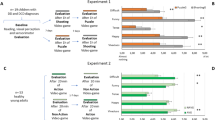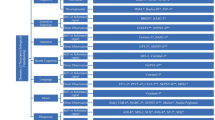Abstract
In nonretarded autistic, receptive developmental language disordered, and normal subject groups, we recorded in auditory and visual target detection tasks two neurophysiological components of the event-related brain potential, Nc and P3b. Existent research shows that, in normals, Nc and P3b appear early in development, are associated with attention and memory processes, and are endogenous which means that they are triggered by internal, consciously initiated attentional and cognitive mechanisms and that they can be triggered even by theomission of sensory stimulation so long as it has meaning or importance for the subject. In this report, Nc and P3b were recorded in response to auditory and visual stimulation and to the omission of auditory and visual stimulation. Consistent with the hypothesis that nonretarded autism involves abnormal attentional and cognitive responses to important information, P3b was found to be smaller than normal and Nc was small and often absent in the nonretarded autistic group even under the condition when no auditory language or sensory processing was required. Receptive developmental language disorder has been linked with difficulties in processing sequences of auditory stimuli, and in this study P3b was found to be somewhat enlarged in this group even under the conditions when P3b was elicited by stimuli separated by 1 sec and also when P3b was elicited by the omission of stimulation.
Similar content being viewed by others
References
American Psychiatric Association. (1980).Diagnostic and statistical manual of mental disorders (3rd ed.). Washington, DC: Author.
Benson, D. F. (1985). Aphasia. In K. M. Heilman & E. Valenstein (Eds.),Clinical Neuropsychology (pp. 17–47). New York: Oxford University Press.
Castaigne, P., Bige, A., Escourolle, R., & Masson, M. (1962). Remollissement pedonculaire median, tegmento-thalmique avec ophtalmoplegie et hypersomnie.Revue Neurologique, 106, 357–367.
Cohen, D. J., Caparulo, B., & Shaywitz, B. (1976). Primary childhood aphasia and childhood autism.Journal of the American Academy of Child Psychiatry, 15, 604–646.
Courchesne, E. (1977). Event-related brain potentials: A comparison between children and adults.Science, 197, 589–592.
Courchesne, E. (1978). Neuorphysiological correlates of cognitive development: Changes in long-latency event-related potentials from childhood to adulthood.Electroencephalography and Clinical Neuorphysiology, 45, 468–482.
Courchesne, E. (1983). Cognitive components of the event-related brain potential: Changes associated with development. In A. W. K. Gaillard & W. Ritter (Eds.), mTutorials in event-related potential research: Endogenous components (pp. 329–344). Amsterdam: Elsevier/North Holland.
Courchesne, E. (1987). A neurophysiological view of autism. In E. Schopler & G. B. Mesibov (Eds.),Neurobiological issues in autism (pp. 285–324). New York: Plenum Press.
Courchesne, E. (in press). Chronology of postnatal human brain development: ERP, PET, Myelinogenesis, and synaptogenesis studies. In J. W. Rohrbaugh, R. Parasumaraman, & R. Johnson (Eds.),Event-related brain potentials: Issues and interdisciplinary vantages. New York: Oxford Press.
Courchesne, E., Courchesne, R. Y., Hicks, G., & Lincoln, A. J. (1985). Functioning of the brainstem auditory pathway in non-retarded autistic individuals.Electroencephaloghaphy and Clinical Neurophysiology, 61, 491–501.
Courchesne, E., Elmasian, R., & Yeung-Courchesne, R. (1987). Electrophysiological correlates of cognitive processing: P3b and Nc, basic, clinical, and developmental research. In A. M. Halliday, S. R. Butler, & R. Paul (Eds.),A Textbook of Clinical Neurophysiology (pp. 645–676). New York: Wiley.
Courchesne, E., Ganz, L., & Norcia, A. M. (1981). Event-related brain potentials to human faces in infants.Child Development, 52, 804–811.
Courchesne, E., Hesselink, J. R., Jernigan, T. L., & Yeung-Courchesne, R. (1987). Abnormal neuroanatomy in a non-retarded person with autism. Unusual findings with magnetic resonance imaging.Archives of Neurology, 44, 335–341.
Courchesne, E., Kilman, B., Galambos, R., & Lincoln, A. J. (1984). Autism: Procesisng of novel auditory information assessed by event-related brain potentials.Electroencephalography and Clinical Neurophysiology, 59, 238–248.
Courchesne, E., Lincoln, A. J., Kilman, B. A., & Galambos, R. (1985). Event-related brain potential correlates of the processing of novel visual and auditory information in autism.Journal of Autism and Developmental Disorders, 15, 55–76.
Courchesne, E., & Yeung-Courchesne, R. (1987). Event-related brain potentials and developmental psychopathologies. In M. Rutter, H. Tuma, & I. Lann (Eds.),Assessment and diagnosis in child and adolescent psychopathology (pp. 264–299). New York: Guilford Press.
Courchesne, E., Yeung-Courchesne, R., Press, G., Hesselink, J. R., & Jernigan, T. L. (1988). Hypoplasia of cerebellar vermal lobules VI and VII in infantile autism.New England Journal of Medicine, 318, 1349–1354.
Damasio, A. R., & Maurer, R. G. (1978). A neurological model for childhood autism.Archives of Neurology, 35, 777–786.
Dawson, G., Finely, C., Phillips, P., Galpert, L., & Lewy, A. (1988). Reduced P3 amplitude of the event-related brain potentials: Its relationship to language ability in autism.Journal of Autism and Developmental Disorders, 18, 493–504.
DeLong, G. R. (1978). A neurological interpretation of infantile autism. In M. Rutter & E. Schopler (Eds.),Autism: A reappraisal of concepts and treatment (pp. 207–218). New York: Plenum Press.
DeMyer, M. K., Hingtgen, J. LN., & Jackson, R. K. (1981). Infantile autism reviewed: A decade of research.Schizophrenia Bulletin, 7, 390–453.
Facon, E., Steriade, M., & Wertheim, N. (1958). Hypersomnie prolongee engendree par des lesions bilaterales du systeme activateur medial. Le syndrome thrombotique de la bifurcation du tronc basilaire.Revue Neurologique, 106, 357–367.
Friedman, D., Brown, C., Vaughan, H. G., Jr., & Erlenmeyer-Kimling, L. (1984). Cognitive brain potential components in adolescents.Psychophysiology, 21, 83–96.
Gullickson, G. R. (1973). CNV and behavioral attention to a glide-tone warning of interesting non-moving or kaleidoscopic visual or auditory patterns in 2- and 3-year-old children.Electroencephalography and Clinical Neurophysiology, Supplement, 33, 145–150.
Holcomb, P. J., Ackerman, P. T., & Dykman, R. A. (1986). Auditory event-related potentials in attention and reading disabled boys.International Journal of Psychophysiology, 3, 263–273.
Hobson, J. A., & Steriade, M. (1985). The neuronal basis of behavioral state control: Internal systems of the brain. In F. E. Bloom (Series ed.) & V. Mountcastle (Ed.),Handbook of physiology: Volume on intrinsic regulatory systems of the brain. Bethesda, Maryland: American Physiology Society Press.
Holcomb, P. J., Ackerman, P. T., & Dykman, R. A. (1985). Cognitive event-related brain potentials in children with attention and reading deficits.Psychophysiology, 22, 656–667.
Inubishi, S., Kobayashi, T., Oshima, T., & Torii, S. (1978a). Intracellular recordings from the motor cortex during EEG arousal in unanaethetized brain preparations of the cat.Japanese Journal of Physiology, 28, 669–688.
Inubishi, S., Kobayashi, T., Oshima, T., & Torii, S. (1978b). An intracellular analysis of EEG arousal in cat motor cortex.Japanese Journal of Physiology, 28, 689–708.
Kanner, L. (1943). Autistic disturbances of affective contact.Neurvous Child, 2, 217–250.
Karrer, R., & Ackles, P. K. (1987). Visual event-related potentials of infants during a modified oddball procedure. In R. Johnson, Jr., J. W. Rohbaugh, & R. Parasuraman (Eds.),Current trends in event-related potential research (EEG Supplement 40), pp. 603–608. Amsterdam: Elsevier.
Klein, M., Coles, M. G. H., & Donchin, E. (1984). People with absolute pitch process tones without producing a P300.Science, 223, 1306–1309.
Knight, R. T., Scabini, D., Woods, D. L., & Clayworth, C. (submitted). Lesions of the superior temporal gyrus abolish the auditory parietal P300 in humans.
Kok, A., & Rooijakkers, J. A. J. (1985). Comparison of event-related potentials of young children and adults in a visual recognition and word reading task.Psychophysiology, 22, 11–23.
Kurtzberg, D. (1985). Late auditory evoked potentials and speech sound discrimination in newborns. Presented at the meetings of the Society for Research in Child Development, Toronto.
Lincoln, A. J., Courchesne, E., Kilman, B. A., & Galambos, R. (1985). Neurophysiological correlates of information processing in children with Down's syndrome.American Journal of Mental Deficiency, 89, 403–414.
Lincoln, A. J., Courchesne, E., & Elmasian, R. (1987). Hypothesis testing with principal components analysis: the dissociation of P3b and Nc. In R. Johnson Jr., R. Parasuraman, & J. W. Rohrbaugh (Eds.),Current trends in event-related potential research (EEG Suppl. 40). Amsterdam: Elsevier, pp. 211–219.
Lincoln, A. J., Courchesne, E., Kilman, B. A., Elmasian, R., & Allen, M. (1988). A study of intellectual abilities in high-functioning people with autism.Journal of Autism and Developmental Disorders, 18, 505–524.
Loiselle, D. L., Stamm, J. S., Maitinsky, S., & Whipple, S. C. (1980). Evoked potential and behavioral signs of attentive dysfunctions in hyperactive boys.Psychophysiology, 17, 193–201.
Lovrich, D., & Stamm, J. S. (1983). Event-related potential and behavior correlates of attention in reading retardation.Journal of Clinical Neurophysiology, 5, 13–37.
Moruzzi, G., & Magoun, H. W. (1949). Brainstem reticular formation and activation of the EEG.Electroencephalography and Clinical Neurophysiology, 1, 455–473.
Mullis, R. J., Holcomb, P. J., Diner, B. C., & Dykman, R. A. (1985). The effects of aging on the P3 component of the visual event-related potential.Electroencephalography and Clinical Neurophysiology, 62, 141–149.
Nakamura, K., Toshima, T., & Takemura, I. (1986). The comparative and developmental study of auditory information processing in autistic adults.Journal of Autism and Developmental Disorders, 16, 105–118.
Novick, B., Kurtzberg, D., & Vaughan, Jr., H. G. (1979). An electrophysiologic indication of defective information storage in childhood autism.Psychiatry Research, 1, 101–108.
Novick, B., Vaughan, H. G., Jr., Kurtzberg, D., & Simson, R. (1980). An electrophysiologic indication of auditory processing defects in autism.Psychiatry Research, 3, 107–114.
Ornitz, E. M. (1985). Neurophysiology of infantile autism.Journal of the American Academy of Child Psychiatry, 24, 251–262.
Ornitz, E. M., & Ritvo, E. R. (1968). Perceptual inconstancy in early infantile autism.Archives of General Psychiatry, 18, 76–98.
Pritchard, W. S. (1981). Psychophysiology of P300.Psychological Bulletin, 89, 506–540.
Rimland, B. (1964).Infantile Autism: The Syndrome and Its Implications. New York: Appleton Century Crofts.
Rutter, M. (1978a). Diagnosis and definition. In M. Rutter & E. Schopler (Eds.),Autism: A reappraisal of concepts and treatment (pp. 1–25). New York: Plenum Press.
Rutter, M. (1978b). Language disorder and infantile autism. In M. Rutter & E. Schopler (Eds.),Autism: A reappraisal of concepts and treatment pp. 85–104). New York: Plenum Press.
Steriade, M., & Glenn, L. (1982). Neocortical and caudate projections of intralaminar thalamic neurons and their synaptic excitation from midbrain reticular core.Journal of Neuophysiology, 48, 352–371.
Sutton, S., & Ruchkin, D. S. (1984). The late positive complex: Advances and new problems. InBrain and information: Event-related potentials. Annals of the New York Academy of Science, 425, 1–23.
Sutton, S., Tueting, P., Zubin, J., & John, E. R. (1967). Information delivery and the sensory evoked potential.Science, 155, 1436–1439.
Symmes, D., & Eisengart, M. A. (1971). Evoked response correlates of meaningful visual stimuli in children.Psychophysiology, 8, 769–778.
Tallal, P. (1985). Neuropsychological foundations of specific developmental disorders of speech and language: Implications for theories of hemispheric specialization. In J. O. Cavenar (Ed.),Psychiatry: Psychobiological foundations of clinical psychiatry (Vol. 3, pp. 1–15). Philadelphia: Lippincott.
Tallal, P., Stark, R., Kallman, C., & Mellits, C. (1981). A re-examination of some nonverbal perceptual abilities of language-imparied and normal children as a function of age and sensory modality.Journal of Speech and Hearing Research, 24, 351.
Woods, A. L. & Courchesne, E. (1987). Intersubject variability elucidates the cerebral generators and psychological correlates of ERPs. In R. Johnson, Jr., J. W. Rohrbaugh, & R. Parasuraman (Eds.),Current trends in event-related potential research (EEG Supplement 40) (pp. 293–299). Amsterdam: Elsevier.
Woods, D. L., & Courchesne, E. (1986). The recovery functions of auditory event-related potentials during split-second discriminations.Electroencephalography and Clinical Neurophysiology, 65, 304–315.
Author information
Authors and Affiliations
Additional information
This research was supported by NINCDS grant 5-RO1-NS19855 and NIMH grant 1-R01-MH36840 awarded to E. Courchesne. Thanks to Marta Kutas and Paula Tallal for helpful comments on the manuscript. Valuable assistance has also been provided by San Diego Regional Center for the Developmentally Disabled.
Rights and permissions
About this article
Cite this article
Courchesne, E., Lincoln, A.J., Yeung-Courchesne, R. et al. Pathophysiologic findings in nonretarded autism and receptive developmental language disorder. J Autism Dev Disord 19, 1–17 (1989). https://doi.org/10.1007/BF02212714
Issue Date:
DOI: https://doi.org/10.1007/BF02212714




